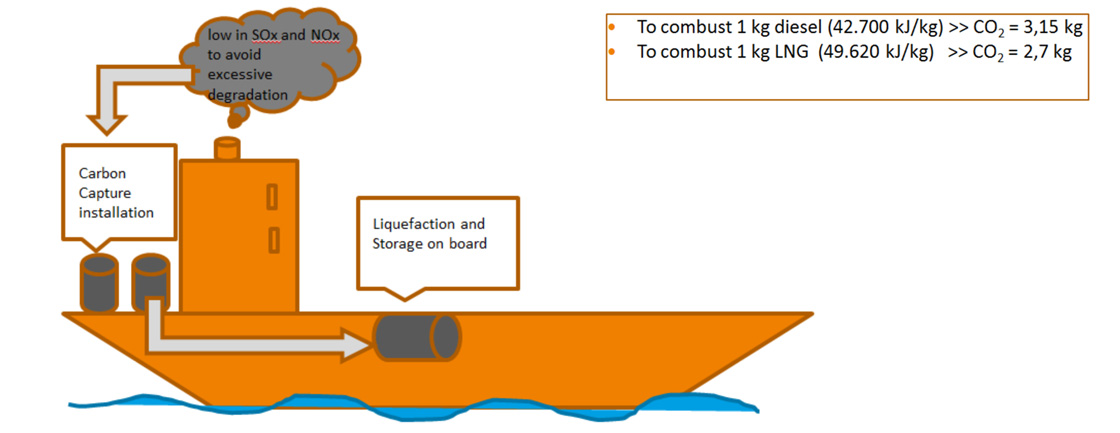GENERAL INFORMATION
CO2 is a greenhouse gas and is proven to play a major role in accelerating the damaging effects of climate change. International, European and national strategies for the reduction of CO2-emissions are being developed to meet the requirements of the Paris 2015 Climate Agreement. According to the third IMO Greenhouse Gas Study from 2014, shipping is responsible for almost 3% of global CO2-emissions.1 CO2 – emissions from shipping can be reduced to some extent through operational measures such as efficient steaming, or using alternative fuels such as for example LNG. Still, the impact of such measures on CO2-emission reduction remains limited.
From 2017 onwards, seagoing ships that enter European seaports will be required to submit a CO2-monitoring plan upon request and in 2019 the European Commission will make the CO2-performance of ships publicly available. As soon as this emission data becomes publicly available, it is the expectation that some form of legal CO2-emission monitoring and management system for the marine sector will sooner or later emerge.
It has become evident that methods for capturing CO2 capture following the burning of fossil fuels will need to be deployed in order to be able to meet future emission standards. Carbon capture techniques are already being successfully deployed in various land-based power plants, both as demonstrators as well as on a wider commercial scale.
Carbon capture technology is a well-known application that is suitable for large stationary power plants on land that use fossil fuels and it is technically feasible to scale down to the size required for ships.
However, the problem remains in meeting the high energy requirements of these power plant applications to capture CO2 from flue gas. One possibility is to make use of the unused heat which is currently under-utilized as an energy source on board. Such energy losses stem from the hot exhaust-gases and under-utilisation of the cooling water system. When gaseous CO2 has been captured on board, it can potentially be liquefied and stored in cryogenic pressure tanks. In the case of LNG fueled ships, the liquefaction of CO2 can be done energy neutral.
CHALLENGES
The main innovative aspect is based upon understanding the feasibility of designing and demonstrating small scale, highly energy-integrated and fit-for-purpose carbon capture units that can be an economical addition to the range of measures to reduce marine CO2-emissions. Further opportunities for reduction of capital costs and hence increasing the attractiveness of capturing and storing CO2 on board of a ship are based on standardisation and large volume production.

The targeted users in the maritime sector currently have no experience with these kind of capture units and would therefore require a demonstration plant to understand the implications on ship operation, economic impact and scale.
INNOVATION TARGET
The development and demonstration of a CO2-capture and storage unit for ships will achieve:
- A high (energy-) efficiency of the unit on board
- A compact, economically feasible carbon capture unit
- An efficient and economically feasible storage (cryogenic, pressurized) of liquefied CO2 on board of a ship
- Optimised integration with available excess heat and cold on board of a ship
- An adequate and well organised distribution chain for liquid CO2 covering the storage on board of a ship, offloading in a port or terminal and further distribution to end users
- dentification of alternative applications for liquid CO2 originating from the maritime sector
BACKGROUND TO THIS INITIATIVE
The groundwork for this project is currently being laid in a parallel initiative, the Maritime Carbon Capture & Storage networking project, funded by the INTERREG V-A Program Deutschland-Nederland. Partners in this project are MARIKO GmbH, FME, ZEMprojects and TNO. A targeted outcome will be a technology roadmap and the establishment of a SME network concentrated on CO2 capture in inland waterways and shortsea shipping. This will lay the groundwork for future cross-border initiatives leading to the development, testing and demonstration of innovative CO2 capture and storage technologies for the maritime sector
More information about this innovation project:
MARIKO: Katja Baumann, Managing Director, MARIKO GmbH
Email: katja.baumann@mariko-leer.de
Phone: +49 491 926 1117
FME: Leo van der Burg, Business Development Manager, FME Regio Noord
Email: leo.van.der.burg@fme.nl
Phone: +31 650 66 27 45
1) GHG3 Executive Summary and Report